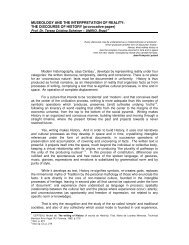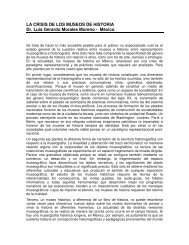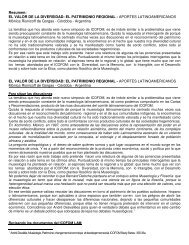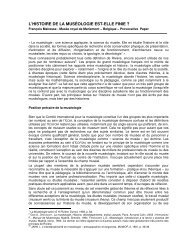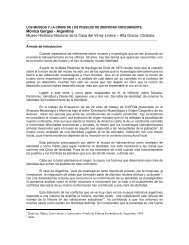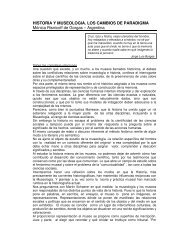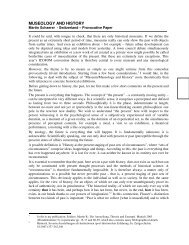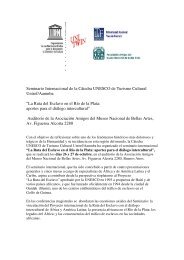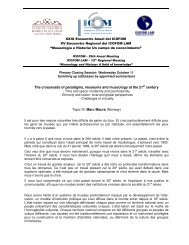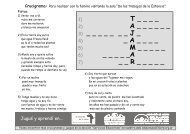ethics and the transmission of memory dr. anita bharat shah, india
ethics and the transmission of memory dr. anita bharat shah, india
ethics and the transmission of memory dr. anita bharat shah, india
You also want an ePaper? Increase the reach of your titles
YUMPU automatically turns print PDFs into web optimized ePapers that Google loves.
XXIX Encuentro Anual del ICOFOM<br />
XV Encuentro Regional del ICOFOM LAM<br />
“Museología e Historia: Un campo de conocimiento”<br />
ICOFOM - 29th Anual Meeting<br />
ICOFOM LAM – 15 th Regional Meeting<br />
“Museology <strong>and</strong> History: A field <strong>of</strong> knowledge”<br />
ETHICS AND THE TRANSMISSION OF MEMORY<br />
DR. ANITA BHARAT SHAH, INDIA<br />
Museologists are at present concerned with exploring, developing <strong>and</strong> redefining concepts that can<br />
give solutions to <strong>the</strong> problems confronting museums in <strong>the</strong>ir quest for a balance between <strong>the</strong> past <strong>and</strong><br />
<strong>the</strong> present. These problems are particularly acute in <strong>the</strong> museum’s presentation <strong>of</strong> historical material<br />
conveying a specific reading <strong>of</strong> history.<br />
Two concepts will be important here, <strong>the</strong> museum as an environment for education <strong>and</strong> <strong>the</strong><br />
interpretation <strong>of</strong> reality. The museum provides a stimulating environment which is an excellent<br />
informal channel <strong>of</strong> communication <strong>and</strong> learning. The museum is a place where you learn from <strong>the</strong><br />
past, assimilate <strong>the</strong> content <strong>and</strong> go back to think about <strong>the</strong> present <strong>and</strong> probably re-plan <strong>the</strong> future; a<br />
place where people feel <strong>the</strong>y can debate, discuss <strong>and</strong> create meanings for <strong>the</strong>mselves.<br />
The museum is a specific phenomenon <strong>of</strong> man’s approach to reality. Museology fulfills its role as a<br />
specific science by evaluating what impact <strong>the</strong> museum as a whole can have on <strong>the</strong> social<br />
consciousness <strong>of</strong> its audience. For <strong>the</strong> museum to have an impact on its audience it has to ‘h<strong>and</strong>le’<br />
<strong>the</strong> tangible <strong>and</strong> intangible heritage it wants to portray in a sensitive fashion. Interpretation <strong>of</strong> historical<br />
material is not always straight forward. The value <strong>of</strong> <strong>the</strong> object is not intrinsic to it, but is highly<br />
dependent on <strong>the</strong> object-subject relation that is brought out by <strong>the</strong> museologist. The presentation <strong>of</strong><br />
objects has to be synchronized with <strong>the</strong> process <strong>of</strong> musealization <strong>of</strong> objects; o<strong>the</strong>rwise <strong>the</strong> museum<br />
value attributed to <strong>the</strong> object would loose <strong>the</strong>ir true value dimension. The work <strong>of</strong> presentation is<br />
closely related to visual language <strong>of</strong> grammar, syntax <strong>and</strong> its intuitive appeal. The creation <strong>of</strong> <strong>the</strong><br />
museum medium must be based on <strong>the</strong> scientific explanation <strong>of</strong> historical, cultural, religious, social<br />
<strong>and</strong> aes<strong>the</strong>tic values <strong>and</strong> <strong>the</strong> decoding <strong>of</strong> symbolized philosophical concepts attributed by <strong>the</strong> given<br />
culture to <strong>the</strong> object. Success lies in how creatively <strong>the</strong> museologist presents this insight to <strong>the</strong> public<br />
so as to capture his attention, imagination <strong>and</strong> eventually pierce his underst<strong>and</strong>ing.<br />
To achieve this very fundamental goal museums <strong>and</strong> museum pr<strong>of</strong>essionals all over <strong>the</strong> world would<br />
benefit greatly by following a st<strong>and</strong>ardized code <strong>of</strong> <strong>ethics</strong>. Our basic aim would be to promote <strong>the</strong><br />
norms <strong>of</strong> cultural diversity as a natural phenomenon, <strong>and</strong> as an integral aspect <strong>of</strong> <strong>the</strong> fundamental<br />
rights <strong>of</strong> human beings. An important objective <strong>of</strong> <strong>the</strong> museum, as a social institution, is to work<br />
towards global peace <strong>and</strong> underst<strong>and</strong>ing.<br />
The cultural diversity <strong>of</strong> India is proverbial <strong>and</strong> it stretches <strong>the</strong> boundaries <strong>of</strong> one’s imagination. The<br />
Indian Constitution has accepted <strong>the</strong> ethnic <strong>and</strong> cultural plurality <strong>of</strong> India as a fact <strong>of</strong> reality <strong>and</strong><br />
<strong>the</strong>refore guarantees equality <strong>of</strong> rights irrespective <strong>of</strong> caste, creed, sect, religion, gender etc. Thus<br />
coming from a country with cultural diversity <strong>of</strong> immense dimensions I put before you a set <strong>of</strong> <strong>ethics</strong><br />
which I think are relevant to present times. However, <strong>the</strong> following points have to be discussed <strong>and</strong><br />
deliberated upon.<br />
Museums are windows <strong>of</strong> society <strong>and</strong> strive to present <strong>the</strong> experiences <strong>of</strong> people <strong>the</strong> world over. To<br />
achieve its goals effectively, to reach out to <strong>the</strong> public, to touch <strong>the</strong> relevant chords, to trigger attitude<br />
change <strong>and</strong> better underst<strong>and</strong>ing <strong>of</strong> various cultures, museologists have to take up intensive research
into <strong>the</strong> cultural material that <strong>the</strong>y are going to exhibit focusing on its social <strong>and</strong> cultural significance.<br />
Inter disciplinary approach <strong>and</strong> <strong>the</strong> close involvement <strong>of</strong> <strong>the</strong> people to whom <strong>the</strong> culture belongs can<br />
broaden <strong>the</strong> scope <strong>and</strong> dimension <strong>of</strong> <strong>the</strong> exhibition. Failing to consult with <strong>the</strong> community, whose<br />
traditions <strong>and</strong> history is being exhibited may cause complications leading to misinterpretation <strong>and</strong><br />
defeating <strong>the</strong> very cause <strong>of</strong> <strong>the</strong> museum. The method by which material culture <strong>of</strong> a society is<br />
displayed, <strong>the</strong> reactions <strong>of</strong> <strong>the</strong> public <strong>and</strong> <strong>the</strong> repercussions are <strong>the</strong> most sensitive issues <strong>of</strong><br />
museology today.<br />
Prejudices <strong>and</strong> stereotyping arise among people because <strong>of</strong> misconceptions <strong>and</strong> lack <strong>of</strong><br />
underst<strong>and</strong>ing <strong>of</strong> culture properly. India was misconceived by people <strong>of</strong> o<strong>the</strong>r countries, in spite <strong>of</strong> its<br />
five thous<strong>and</strong> years <strong>of</strong> continual civilization <strong>and</strong> a very rich cultural heritage. India, prior to <strong>the</strong> 1970s<br />
was conceived by <strong>the</strong> common people abroad as a country <strong>of</strong> snake charmers <strong>and</strong> Indians were<br />
basically perceived as superstitious, backward, ignorant <strong>and</strong> poverty stricken. However, well planned<br />
exhibitions <strong>of</strong> Indian culture organized by <strong>the</strong> Government <strong>of</strong> India <strong>and</strong> Indian museums abroad<br />
helped to clear out <strong>the</strong>se misconceptions.<br />
Ano<strong>the</strong>r very important point I would like to put forward is <strong>the</strong> issue <strong>of</strong> ‘br<strong>and</strong>ing’ cultures. Museums<br />
<strong>and</strong> museologists must refrain from br<strong>and</strong>ing cultures as ‘exotic’, ‘dominant’, ‘fundamentalist’ etc.<br />
<strong>the</strong>se adjectives promote stereotyping <strong>of</strong> cultures, which could lead to stimulating negative reactions.<br />
Ano<strong>the</strong>r important issue is <strong>the</strong> sensitivity involved in exhibiting sacred objects <strong>and</strong> cultural material <strong>of</strong><br />
indigenous cultures. Museologists have to respect <strong>the</strong> fact that every culture has <strong>the</strong> right to decide<br />
what is ‘good’ for itself. This fundamental right must be respected in all its aspects. Tribal communities<br />
<strong>and</strong> indigenous people become a target <strong>of</strong> misconceptions even in India.<br />
They are presumed to be exotic, apparently devoid <strong>of</strong> rationality <strong>and</strong> having little awareness about<br />
realities <strong>of</strong> life. They are by <strong>and</strong> large projected on <strong>the</strong> basis <strong>of</strong> <strong>the</strong> image portrayed by <strong>the</strong> non-tribes.<br />
They are hardly given <strong>the</strong> opportunity to have any self-image. There is a general tendency to view<br />
<strong>the</strong>ir customs <strong>and</strong> traditions as queer, <strong>and</strong> to regard <strong>the</strong>ir culture with skepticism.<br />
There appears to be an inclination to transform or reshape <strong>the</strong>ir customs, practices <strong>and</strong> culture, <strong>and</strong><br />
to amalgamate <strong>the</strong>m into <strong>the</strong> mainstream <strong>of</strong> society. This attitude totally disregards <strong>the</strong>ir right to live<br />
with what <strong>the</strong>y have inherited, <strong>and</strong> <strong>the</strong>ir right to decide what is ‘good’ for <strong>the</strong>m. They are put under<br />
pressure to give up <strong>the</strong>ir customs <strong>and</strong> traditions <strong>and</strong> reorganize <strong>the</strong>ir lives to ‘fit’ into <strong>the</strong> mainstream<br />
<strong>of</strong> modern man. Thus a sort <strong>of</strong> unseen hierarchy gets established between cultures, relegating <strong>the</strong><br />
tribal <strong>and</strong> indigenous cultures to relatively inferior positions.<br />
Museologists must <strong>the</strong>refore apply caution <strong>and</strong> examine <strong>the</strong> tribal <strong>and</strong> indigenous cultures as<br />
objectively as possible, at <strong>the</strong> same time applying a humane sensitivity to underst<strong>and</strong> <strong>the</strong>ir cultures as<br />
intimately as possible. The main strength <strong>of</strong> an exhibition would rest on <strong>the</strong> spirit <strong>of</strong> mutual tolerance<br />
<strong>and</strong> demonstration <strong>of</strong> respect communicated through it as a whole.<br />
Cultural diversity as <strong>the</strong> strategy <strong>of</strong> interest alliance is likely to be seen differently in <strong>the</strong> context <strong>of</strong><br />
mono-ethnic <strong>and</strong> pluri-cultural countries. Mono-ethnic countries pr<strong>of</strong>ess emphasis on <strong>the</strong> attributes <strong>of</strong><br />
uniformity, setting <strong>the</strong>ir goals towards consequential homogenization. However, pluri-cultural<br />
countries <strong>and</strong> also in <strong>the</strong> global context we have to accept cultural diversity as <strong>the</strong> order <strong>of</strong> <strong>the</strong> day.<br />
Museums <strong>and</strong> museologists have to face <strong>the</strong> challenge <strong>of</strong> cultivating an atmosphere <strong>of</strong> mutual<br />
tolerance <strong>and</strong> acceptance. Thus <strong>the</strong> concern for protection <strong>of</strong> culture, language, traditions, customs,<br />
identity <strong>and</strong> resistance against oppression <strong>and</strong> overexploitation should be conspicuously manifest in<br />
<strong>the</strong> museum’s policies, keeping always in mind that <strong>the</strong> main goal <strong>of</strong> <strong>the</strong> museum is to promote global<br />
peace <strong>and</strong> harmony.<br />
Ano<strong>the</strong>r sensitive issue is <strong>the</strong> presentation <strong>of</strong> socially sensitive historical material. In <strong>the</strong> year 2000 I<br />
had <strong>the</strong> opportunity to set up a small museum consisting <strong>of</strong> a collection that belonged to <strong>the</strong> Seventh<br />
Nizam <strong>of</strong> Hyderabad State. The Nizam, a Muslim ruler, ruled Hyderabad before India became<br />
independent. The collection consisted <strong>of</strong> silver models <strong>of</strong> various buildings <strong>the</strong> Nizam built during his<br />
reign in Hyderabad. During his reign as a king he had held toge<strong>the</strong>r a fragile social <strong>and</strong> ethnic balance<br />
between <strong>the</strong> various communities <strong>of</strong> <strong>the</strong> region. This balance <strong>of</strong> social harmony was very superficial,<br />
<strong>and</strong> <strong>the</strong> Nizam’s administration committed atrocities on <strong>the</strong> majority <strong>of</strong> <strong>the</strong> Hindu population. This<br />
disharmony came out into <strong>the</strong> open when <strong>the</strong> 7 th Nizam refused to join <strong>the</strong> Union <strong>of</strong> States <strong>of</strong><br />
Independent India <strong>and</strong> started <strong>the</strong> Razakar movement unleashing a reign <strong>of</strong> terror on <strong>the</strong> Hindu<br />
community for 13 months. Eventually, <strong>the</strong> Government <strong>of</strong> India sent its troops <strong>and</strong> Hyderabad state<br />
became a part <strong>of</strong> independent India in 1948. The citizens <strong>of</strong> Hyderabad state were unable to erase
<strong>the</strong> terrifying experiences from <strong>the</strong>ir collective <strong>memory</strong>, especially <strong>the</strong> events that occurred between<br />
1947 <strong>and</strong> 1948.<br />
The question that arises here is how do we interpret this negative reality<br />
Do we manipulate history to achieve our goals or do we present reality in its true form<br />
How can we interpret this reality<br />
The above experience is not exceptional in <strong>the</strong> museum world. There have been many such historical<br />
events that are difficult to portray in <strong>the</strong> museum environment.<br />
Thus interpretation <strong>of</strong> reality <strong>and</strong> <strong>the</strong> <strong>transmission</strong> <strong>of</strong> <strong>memory</strong> with high ethical st<strong>and</strong>ards is not as<br />
simple as it may seem in <strong>the</strong> museum context. The learning gradient <strong>of</strong> experience, interpretation <strong>and</strong><br />
underst<strong>and</strong>ing is not a gradual one. Past <strong>and</strong> present experiences toge<strong>the</strong>r with projected meanings<br />
interact to give a complex underst<strong>and</strong>ing. Expectations, past experiences <strong>of</strong> <strong>the</strong> visitors, projections,<br />
<strong>and</strong> identifications are all implicated in <strong>the</strong> total museum experience. What <strong>the</strong> visitors bring with <strong>the</strong>m<br />
<strong>and</strong> will take back, both have to be carefully pondered upon.<br />
The role <strong>of</strong> <strong>the</strong> museum is to build bridges <strong>and</strong> open dialogues between cultures working towards<br />
reducing ethnic strife at <strong>the</strong> same time preserving <strong>the</strong> delicate fabric <strong>of</strong> cultural diversity <strong>of</strong> mankind,<br />
thus enriching <strong>the</strong> quality <strong>of</strong> human life on earth.



